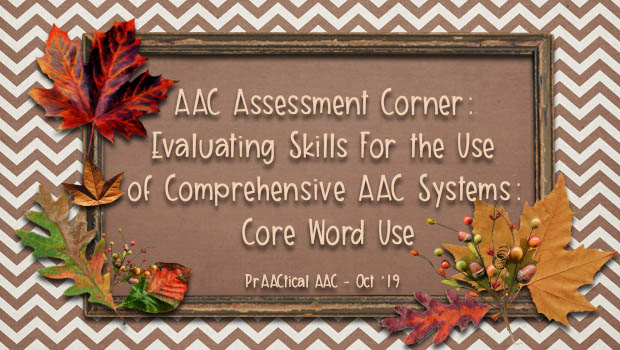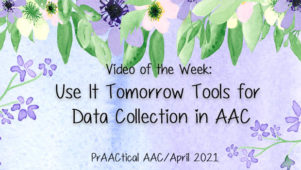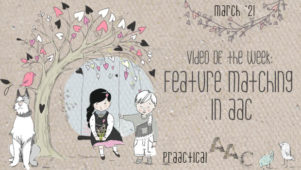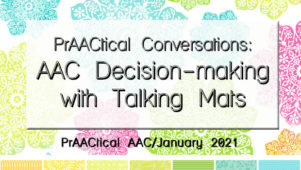AAC Assessment Corner: Evaluating Skills For the Use of Comprehensive AAC Systems – Core Word Use

 We are so very pleased to welcome Vicki Clarke back to these pages for another installment in our AAC Assessment Corner. Vicki is the CEO of Dynamic Therapy Associates and Director of DTA Schools, is back with another wonderful edition of AAC Assessment Corner. In addition to their clinic, Vicki and her team support school districts in AAC evaluation, equipment procurement, and implementation for individual students in the academic environment. DTA Schools also supports district-wide AAC implementation through the Classroom Communication Goals Project, training, and supporting all team members in classroom AAC implementation.
We are so very pleased to welcome Vicki Clarke back to these pages for another installment in our AAC Assessment Corner. Vicki is the CEO of Dynamic Therapy Associates and Director of DTA Schools, is back with another wonderful edition of AAC Assessment Corner. In addition to their clinic, Vicki and her team support school districts in AAC evaluation, equipment procurement, and implementation for individual students in the academic environment. DTA Schools also supports district-wide AAC implementation through the Classroom Communication Goals Project, training, and supporting all team members in classroom AAC implementation.
::::::::::::::::::::::::::::::::::::::::::::::::::::::::::::::::::::::::::::::::::::::::::::::::::::::::::::::
Evaluating Skills For the Use of Comprehensive AAC Systems: CORE WORD USE ACTION/OBJECT REQUESTS-RECURRENCE, CESSATION, ACTION
More, Stop, Go and Want
Once we have assessed our student’s ability to understand and use photos and symbols for concrete, motivating items, it’s time to take a look at their ability to understand and use more abstract, generalizable core vocabulary. Core vocabulary is an important part of our language. As you’ve probably heard, core words are the 200-400 words that make up approximately 80% of all the words we use each day. We know that a typically developing 5-year old is expected to understand and use 3000-5000 words.1 I vividly remember having a mild panic attack driving down I-40 in North Carolina while contemplating being solely responsible for deciding which 60 words I was going to give my little 5-year-old patient, Sarah. She was a delightful, nonspeaking little girl with Cerebral Palsy, who had a LOT to say. How in the world was I to decide which 60 words to give her first? Suffice it to say, in 1989, I made a poor choice, full of general nouns and specific items for requesting, and sorely lacking in frequently-used, flexible core vocabulary. Today a student of mine, like Sarah, would have some of these same specific items on her device, but she’d also have a nice robust set of meaningful core words.
Core words are abstract though. Assessing a student’s understanding and use of these little words of language is more challenging than simply tempting the child with yummy snacks or a favorite video and waiting for her to touch a corresponding symbol. In the earlier section of our assessment, we’ve shown our student that he can get what he wants simply by touching a picture, now we need to see if he can make the symbolic leap to use more abstract symbols for this same purpose. On the Dynamic AAC Skills Assessment-R, you’ll see that I’ve broken down core word understanding and use into two parts, Action/Object Requests and Commenting.
CORE WORD USE ACTION/OBJECT REQUESTS-RECURRENCE, CESSATION, ACTION
We start concrete, observable core word requests because we can apply highly motivating outcomes to the use of these core words. One of the objections we often hear about the use of core vocabulary with early communicators is that words like “it,” “can” and “have” are not motivating. That is a relevant concern because early communication and subsequent word learning is driven by interest and motivation.2 This may be “mama” to get our favorite person to come over; “cookie” to get our favorite treat; or “go” to get a push on the swing. Some core vocabulary CAN be highly personally motivating, however, and those are the words we assess first. Touching the symbol “go” and getting to twirl in Mom’s arms may be extremely exciting. Saying “stop” and getting a break from work can also be very rewarding. The symbols though are not terribly “iconic,” meaning the symbols don’t really look anything like the concept they represent. This lack of iconicity may impact how our students learn the meaning of symbols.3 Our students most likely will need to either read the label or learn the meaning of the picture icon through modeling, direct instruction, repetition and/or functional outcomes. Because these concrete core vocabulary words can be used for more intrinsically rewarding action and object requests, we assess these separate from use of core vocabulary for other communicative functions.
DIRECTIONS: Using a comprehensive AAC app, or a core word board, see if the student can use core words “more” “go” and “stop/all done” to control the activity. Usually, these words are on a main page or a specified “core” word page. Model asking for “more” snack, video or music. Model “go” to wind up a wind-up toy, push a swing, slide down the slide or, start a song. Give a verbal prep statement such as “ready, set…” Gradually decrease prompting from a direct point cue at the symbol to a point in the general area of the symbol with a verbal cue, “do you want MORE?” Ultimately stop cueing and see if the student will start to touch the symbol independently. When s/he begins to show waning interest, encourage the use of “stop” and offer another choice. Remember motivation to communicate is critical, so if the student’s interest is declining, it’s time to move to another activity. Check to see if, over several trials, the student begins to use these core words spontaneously.
How to Present Core Words
You’ll hear professionals recommending that you start teaching a core word by isolating it. People do this in different ways, some beginning with a simple single message voice output switch that says “more.” The disadvantage of this technique is that when the word is isolated, the student may learn it as a simple cause/effect response, unrelated to the icon or spoken message. If you present a core word in isolation, be sure to quickly add another icon option so that the student begins to discriminate between symbols and locations, rather than relying on a simple cause/effect response. We want to be sure our student doesn’t learn to press a button without an understanding of the communicative function of the symbol.
Other evaluators recommend presenting a dynamic display device with many symbol locations, but most of them hidden, “masking.” The advantage of masking is that the student learns the meaning of the word by visual recognition, voice output, and location on the screen. Essentially masking gives the student three features to help them learn and recall a symbol, it’s visual appearance, the consistent auditory symbol (spoken word) and the motor movement of accessing the symbol on a page.
As we begin to introduce core vocabulary, it’s important to recognize that all core is not created equal! If you are working with more emergent communicators, you’ll find more success if you start with core that’s “concrete,” and a healthy dose of motivating fringe words!
::::::::::::::::::::::::::::::::::::::::::::::::::::::::::::::::::::::::::::::::::::::::::::::::::::::::::::::
References Consulted:
- Law, F., Mahr, T., Schneeberg, A., & Edwards, J. (2016). Vocabulary size and auditory word recognition in preschool children. Applied Psycholinguistics, 38(1), 89–125. doi: 10.1017/s0142716416000126
- Hollich G., Hirsh-Pasek K., Golinkoff R. M. (2000). I. What does it take to learn a word?. Soc. Res. Child Dev.65 1–16. 10.1002/wcs.1421
- Gevarter, C., O’Reilly, M. F., Rojeski, L., Sammarco, N., Lang, R., Lancioni, G. E., & Sigafoos, J. (2013). Comparisons of intervention components within augmentative and alternative communication systems for individuals with developmental disabilities: A review of the literature. Research in Developmental Disabilities, 34(12), 4404–4414. doi: 10.1016/j.ridd.2013.09.018
Filed under: Featured Posts, PrAACtical Thinking
Tagged With: AAC assessment, Vicki Clarke
This post was written by Carole Zangari




